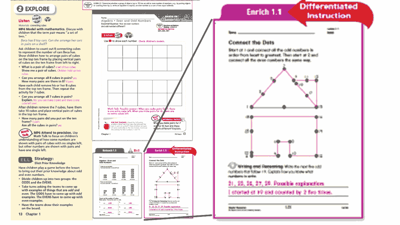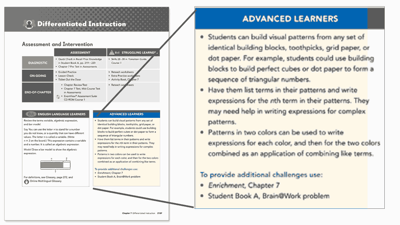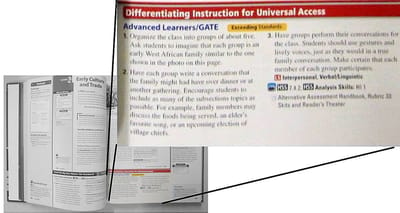Would you help me with a project? I’m looking for examples labeled “differentiation” in textbooks.
I think a study of what passes for “differentiation” in textbooks is fascinating, especially because I often hear from teachers who are not allowed to deviate from their textbooks. If we can’t adapt lessons to students, then we’re stuck with what the textbook provides. This might be ok if textbooks included quality differentiation, but, in my experience, textbooks have very poor examples of what differentiation should look like.
I gathered a few examples I found online (apologies for the low-quality zooms) but would love for you to send in examples from textbooks you use: ian@byrdseed.com.
Suspect 1

Here is an image from a lesson about even and odd numbers. The “Enrich” section is in the bottom right. It’s a connect-the-dots worksheet. Kids connect even numbers to form one shape and odd numbers to form another shape which then forms a house. Is this “enrichment”? Maybe?
I really want to call your attention to the bright red arrow which reads: “Differentiated Instruction”. This caught my eye: Differentiated Instruction. This is a different worksheet… but, do I really need to type this… a worksheet is not instruction.
Based on this textbook page, the teacher would teach the standard lesson to everyone, then (I’d imagine) make all of the students do all of the standard practice problems, and then have kids who finished early do the “enrich” worksheet.
That is not differentiated instruction. Differentiated instruction should adapt the lesson for learners with different needs, not just add on another worksheet.
Now, I will say, I find the idea of connecting dots in different sequences kind of interesting, but, if you’ll think back to the Remembering vs Thinking articles, this version of the task is pure memory.
We always have to ask: is this changing how students are thinking or merely what they are doing?
Suspect 2

Here we have another math lesson, also featuring the words “Differentiated Instruction” across the top. For Advanced Learners:
Students can build visual patterns from any set of identical building blocks, toothpicks, or… grid paper. For example, students could use building blocks to build perfect cubes… Have them list terms in their patterns and write expressions for the nth term…
Again, despite the label, there’s no differentiated instruction here. There’s nothing about modifying what or how we’re teaching students who have different needs. Instead, it’s another example of giving advanced students additional work rather than different instruction.
One statement did stick out to me as interesting:
[Advanced Learners] may need help in writing expressions for complex patterns.
This is noteworthy since it acknowledges that teachers might interact with their advanced learners during work time! What a concept? But I’d go further: advanced learners should need help with their task. Otherwise, we’ve missed their zone of proximal development and they’re not really facing a sufficient challenge.
Suspect 3

Here we have a middle school social studies lesson. Down in the bottom right are our favorite two words: “Differentiated Instruction.” Will this one actually feature instruction or just another worksheet? Here’s the gist for Advanced Learners:
- Put students in groups. They imagine that they’re a family from early West Africa.
- They write a family dinner conversation about the topics from the lesson.
- They perform the conversations in front of the class.
So once again, this textbook doesn’t provide any differentiated instruction under the “Differentiated Instruction” section. It gives some students something different to do, but assumes they’ve received the exact same lesson, the same knowledge, and the same resources as the rest of the class.
Put Them In Groups!
This is a bit of a sneak peek of the next article, but beware of textbooks’ habit of putting advanced students into unsupervised, unstructured groups and asking them to (magically) create complex work. If you survey your students, I’ll bet they hate tasks like this — and for good reason! Even professional writers don’t create in groups of four! How would it even work? Forcing students into a group for unsupervised work is not differentiated instruction.
Your Examples
Have a teacher’s manual? I’d love for you to snap a quick picture of a page labeled “differentiated instruction” or “advanced learners” and email me: ian@byrdseed.com (I’ll keep you anonymous, of course!). If I get enough, I’ll do a roundup in the future.
